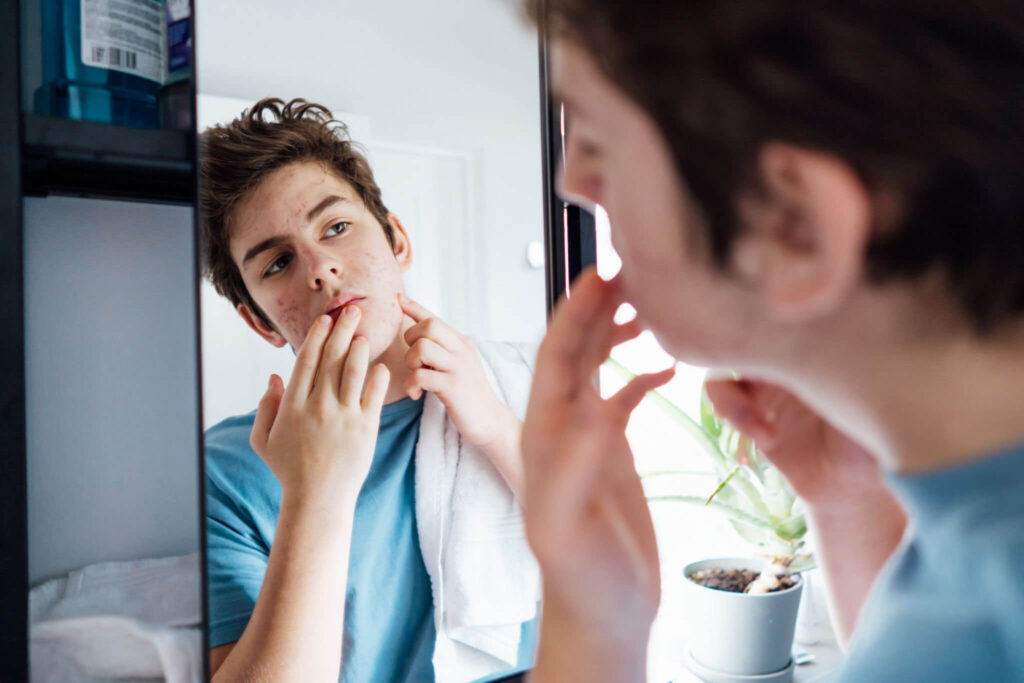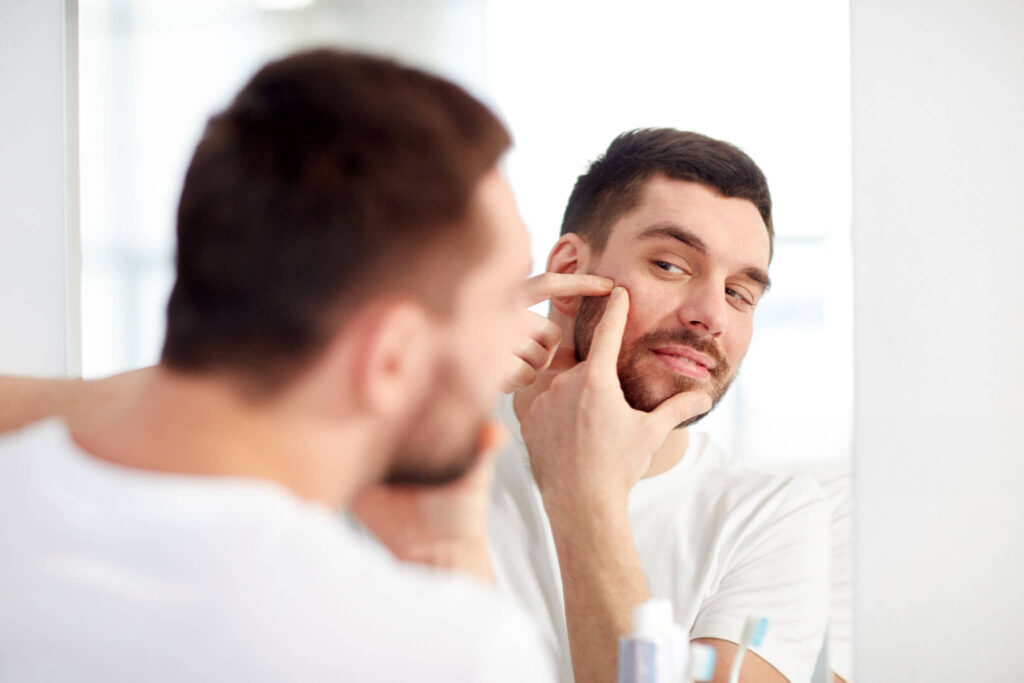Acne

No matter how much you take care of your face, pimples cannot be avoided. When they occur, the question arises: should you express them or not? Here you can find out how to deal with pimples properly, what helps against them and how they develop.
❯ How do pimples develop?
❯ Should you squeeze pimples yes or no?
❯ When should you squeeze a pimple?
❯ Which pimples should you not squeeze?
❯ What happens to pimples if you don’t squeeze them out?
❯ Squeeze out blackheads: What’s the difference?
❯ Squeezing pimples correctly: step by step
❯ Home remedies for pimples
❯ What is the best way to treat pimples?
❯ How can you prevent pimples?
Our body naturally produces its own skin fat, also known as sebum. This fat helps to protect the skin and keep it supple. However, it can sometimes happen that the sebum cannot drain properly from the skin glands, for example if the skin around the pores is more keratinized. This can result in blackheads, which can be either closed or open. These blackheads are also known as white or black comedones. The open blackheads often have a dark spot because the skin pigment melanin reacts with the air.
If bacteria accumulate, the blackhead can become inflamed and an unwanted pimple develops. These pimples are also called “papules” if they look like small nodules, or “pustules” if pus accumulates. There are particularly many sebaceous glands on the face, décolleté, back and shoulders, which is why blackheads and pimples often form there.
During puberty, hormonal changes lead to increased production of skin oils, which often causes teenagers and young adults to suffer from acne. However, it is important to note that the occasional appearance of pimples is not synonymous with acne. Blackheads and spots can usually appear and disappear again in the short term. With real acne, the pimples are more stubborn, develop over a longer period of time and can leave scars. Acne can occur in various forms, from mild to severe, from non-inflammatory to inflammatory.
No matter where the pimple appears, it is often not only unattractive to look at but can also be painful. It is understandable that you want to get rid of it and the possibly visible accumulation of pus. But there are good reasons why it is better not to squeeze a pimple.
There are several reasons why it is better not to squeeze a pimple. Firstly, the pressure can cause the pus to penetrate even deeper into the skin and increase the inflammation of the pimple. Secondly, pressing and squeezing encourages the formation of scars, especially in the case of deeper pimples. And finally, at the latest after the first attempt to squeeze out the pimple, inconspicuous concealment is hardly possible.
So should you squeeze a pimple? The clear answer is: No, it’s better not to push it.
One way to treat pimples and blackheads gently is to visit a medical beauty salon. The specialists there know how to treat pimples hygienically and correctly without causing scars or new inflammation. If you suffer from more severe acne or deeper pimples, you should see your GP or seek advice from a dermatologist.
It is generally best not to squeeze out pimples yourself. However, there are certain situations where squeezing a pick may be acceptable.
In certain situations, squeezing a pimple may be justified. This includes cases where the pimple is mature and can be easily squeezed out when professional help is not available and the pimple is causing severe discomfort. However, it is important to exercise extreme caution and only act if you are sure of what you are doing. If in doubt, it is advisable to seek professional help from a doctor or a qualified skin care expert.
In any case, it is advisable to only squeeze a pimple when it is ripe and you feel safe to do so. If you are unsure or have concerns, it is best to seek professional help from a doctor or a qualified skincare expert.

There are certain types of pimples that it is better not to squeeze out yourself, as this can lead to further complications. These include:
If you don’t squeeze pus pimples, various things can happen. In many cases they can heal naturally without squeezing. The body fights the infection with the help of the immune system and the pimple can clear and heal itself over time. Sometimes the pus is absorbed by your body without causing a visible eruption. This happens when the pimple gradually recedes without opening or deflating.
In some cases, however, a pimple can turn into a cyst, especially if it is deep in the skin. Cysts are closed, fluid-filled structures that can form under the skin and often require medical treatment. If a pimple is not treated, it can also become infected and lead to a major inflammatory reaction. This can lead to swelling, redness and pain and increase the risk of scarring, especially in the case of deeper pimples.
Overall, it is important to note that squeezing pimples is not always the best solution and that it may be better to let them heal naturally, especially if they are not painful or deep under the skin.
When squeezing out blackheads, there are a few differences compared to squeezing out pimples. Blackheads occur when the pores are clogged with sebum and dead skin cells and open up on the surface of the skin, resulting in black spots. In contrast, pimples occur when the pores under the skin become inflamed and form a closed, raised bulge. Less pressure is usually needed when squeezing out blackheads as the pores are open. Special tools such as comedone squeezers are often used to gently remove the blackheads. It is important to squeeze out blackheads and pimples carefully, as improper handling can lead to skin injuries, inflammation and scarring. If you’re unsure, it’s best to seek professional help from a dermatologist or skincare expert.
Squeezing pimples requires caution and hygiene to minimize the risk of infection and scarring. Here is a step-by-step guide on how to squeeze a pimple properly:
It is important to emphasize that squeezing pimples is not suitable for everyone and should only be done on mature pimples.

There are a variety of home remedies that can help you clear up your skin and fight spots. A tried and tested household remedy is tea tree oil, which has antibacterial properties and can reduce inflammation. Simply put a drop on a cotton pad and apply to the affected areas.
Another option is to use honey, which has antibacterial and anti-inflammatory properties. Apply a thin layer of honey to the pimples and leave it on for about 10-15 minutes before rinsing it off with warm water.
Lemon juice is also an effective home remedy for pimples as it is antibacterial and astringent. Apply some freshly squeezed lemon juice to the pimples and leave it on overnight to clear the skin and reduce inflammation.
In addition to these home remedies, you should also pay attention to a healthy lifestyle, which includes a balanced diet, drinking enough water and regular exercise. These measures can help to improve your skin health and reduce spots in the long term.
Try these home remedies and find out which ones work best for your skin.
In addition to these tips, there is the innovative product SkinCare Acne, which uses bacteriophages to combat pimples on the forehead. Bacteriophages are viruses that can selectively attack and kill bacteria without affecting other cells. By targeting the skin bacterium Propionebacterium acnes, SkinCare Acne can help to effectively remove spots and promote clearer skin.
Regular and gentle cleansing of the skin is crucial for optimal care of pimply skin. Use a mild cleanser specially developed for acne-prone skin and wash your face twice a day, morning and evening. Avoid aggressive or irritating products, as these can further irritate the skin. You should then use a light, moisturizing cream or lotion that is non-comedogenic and does not clog the pores. Make sure to choose products that are free of oily ingredients to avoid further clogging of the pores. It is also important to protect the skin from sun exposure by applying a non-comedogenic sunscreen with a sufficiently high sun protection factor every day. When choosing make-up products, you should also make sure to use non-comedogenic, oil-free formulas so as not to further burden the pores. It is advisable to exfoliate the skin regularly to remove dead skin cells and unclog pores. However, use gentle exfoliants so as not to irritate or damage the skin. In addition to external care, a healthy lifestyle is important for skin health. A balanced diet, sufficient sleep, stress management and regular exercise can help to improve the appearance of the skin. If the acne is severe or does not respond to conventional skin care products, you should see a dermatologist for professional treatment.
There are various measures to prevent spots and promote clearer skin.
Regular cleansing of the skin is an important step. Using a gentle cleanser that removes excess oil and dirt can help prevent clogged pores that often lead to pimples. However, it is important not to over-cleanse the skin as this can strip away the skin’s natural oils and lead to further problems.
A balanced diet also plays a decisive role in the prevention of spots. A diet rich in fresh fruits, vegetables and whole grains and low in processed foods and sugary snacks can help improve skin health and reduce the risk of pimples, and proper hydration is important. Drinking plenty of water helps to hydrate the skin and flush toxins from the body, which in turn can reduce the appearance of spots.
Another important aspect is the avoidance of excessive sunlight and the use of sunscreen. UV rays can dry out the skin and lead to inflammation, which can increase the risk of spots. Finally, stress is a factor that can affect skin health. Introducing stress management techniques such as meditation, yoga or regular exercise can help to lower stress levels and reduce the appearance of spots.
By incorporating these measures into your daily routine, you can reduce the likelihood of spots and promote healthier, clearer skin.
Author: Martin Müller
“Various internal and external influences can cause our microbial balance to become unbalanced. Harmful bacteria get out of hand and skin irritations such as redness, itching and eczema are the result. “
Share post: